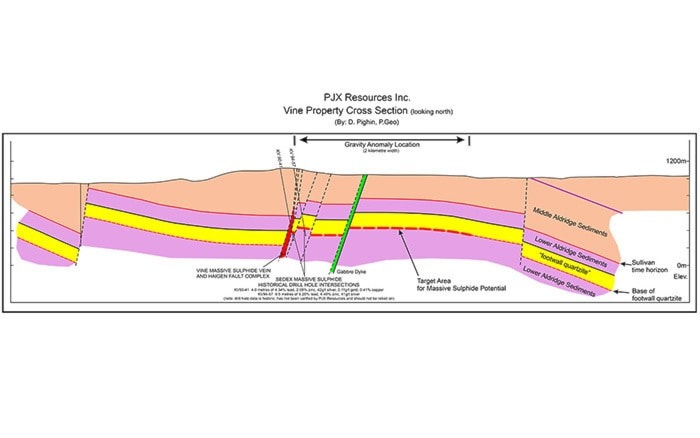A Toronto-based resource company has identified what it describes as a "very promising" gravity anomaly north of Moyie Lake that is similar to the Sullivan Mine deposit.
PJX Resources announced on Thursday, October 24 that gravity tests done on its Vine property earlier this year indicate an area about two kilometres by four kilometres and between 500 metres and 1,500 metres deep that could contain lead, zinc and silver.
"It showed that there was this denser material – it appears to be denser – at depth. It appears to be somewhat flat lying," explained John Keating, PJX's president. "When you put that together, the geophysical company (Excel Geophysics) was thinking that it looks like it could be a sulphide-type deposit. The Sullivan is a massive sulphide that is somewhat flat lying."
It's too soon to know for sure what the dense material is, but it's made more promising because another company drilled in the same area in 1990 and 1994, finding massive sulphides – lead, zinc and silver – at about 700 metres deep.
"Those (drill) holes intersected the massive sulphide at the very edge of this anomaly, the western side of it," said Keating. "So is that massive sulphide representing the gravity target? We don't know. We need to do more detailed gravity work over the area."
The next round of gravity tests, expected to be conducted next month, will isolate parts of the property that are more dense, and at what depth it is.
Then next year, PJX hopes to obtain permits to drill on the property.
"We use the word Sullivan to say that's the type of target we are looking at; it's that kind of style of mineral deposit," said Keating.
"We don't know what it is, but gravity itself shows density changes in the rock."
Gravity testing uses an instrument that is placed on the ground and uses GPS to position itself. Then it tests the density of the ground beneath it.
"Foam is a certain density, wood is denser. When you get to rock like sediments, they have a certain density, and massive sulphides are much more dense," explained Keating.
PJX has also identified a second area where density is present, called the Fors and Smoker area west of the Vine property. Keating said PJX plans to conduct more testing in that area once it has finished testing on the Vine.
For now, the 1990s drilling makes the Vine anomaly an exciting prospect, he went on.
"Since we have these two drill holes that sit on the edge of it, it doesn't confirm that it is massive sulphide, but the correlation is that it could be really good potential. But we have to test it. We don't know for sure. But it looks like a very good target. It's very promising."
